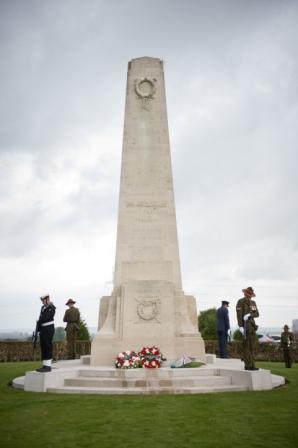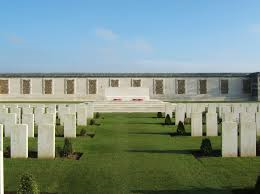Longueval holds a special place in New Zealand's military history during the First World War. It was near this place on Friday, 15 September 1916, that the New Zealand Division joined the Battle of the Somme. From here, at Longueval, many of the important sites of that day are evident. To the west, lies Caterpillar Valley from whence the New Zealand soldiers sprang from their trenches at dawn that day. To the near north is the village of Flers, liberated on the day, while to the east on the skylin

The Army arrived in France in May of that year after service in Egypt and Gallipoli. Made up of veterans of these two campaigns and reinforcements from New Zealand, the New Zealand Division trained, and fought in the country around Armentieres before moving into place in early September as the battle entered its third month. First into action was the New Zealand Field Artillery.
The infantry was in place by midnight of 14 September. The start line is marked today by the rear wall of the Commonwealth War Graves Commission cemetery, Caterpillar Valley, to the west of Longueval. Caterpillar Valley was the name given by the British army to the long valley which rises Eastwards past Caterpillar Wood to the high ground at Guillemont. Longueval village is on the northern edge of this valley and on the road to Bazentin, lies Caterpillar Valley Cemetery.
For the New Zealanders it was a grim prospect. From their positions, to the right lay Longueval village and Delville Wood. To the left lay High Wood and the New Zealanders had advance up a slope towards formidable German positions on a ridge line ahead of them, swept by machine gun and artillery fire.

By 6am on the 15th soldiers had had breakfast and a tot of rum. The Division's official history records a "ghostly pallor was creeping into the sky .. the weather held out every prospect of a fine day." Precisely at 6.20am the guns roared into life and the leading waves of infantry, from the Auckland and Otago regiments went "over the top into action". Each soldier was in light fighting order, with 200 rounds of ammunition and two hand grenades, rations and gas masks, with rifles and bayonets at the high port.
Eight companies advanced across open land between shell holes behind a ferocious artillery barrage that crept ahead of them at the rate of around 50 metres per minute. It was a bitter hand-to-hand fight, with rifle and bayonet but by 6.50am, the German trench line was in New Zealand hands. The advance continued and by late afternoon, the Division had achieved all its objectives, forcing back the enemy and clearing the village of Flers with the 41st Division.
Twenty-six-year-old Sergeant Donald Forrester Brown, of the Otago Regiment, won the Division's first Victoria Cross, the highest award for gallantry in New Zealand and the British Commonwealth during the fighting around Flers. Three times he charged and destroyed enemy strongpoints. He was killed in action on 1 October 1916.
A New Zealand soldier, Lieutenant Alexander Aitken, with the Otago Regiment, who after the war went on to become one of New Zealand's most prominent mathematicians, remembered the battle:
"Heavy German high-explosive shrapnel came up from the other side to burst with terrific crashes and the familiar whorls of black or greenish-yellow smoke. A hundred yards to the rear of us a battery of our own guns was firing continuously.
"By now the German high-explosive shrapnel was bursting thickly in its black and greenish-yellow clouds and the geysers of brown earth thrown up by 5.9inch and 4.1inch shells were spouting all around us. Hardly ever in my life was there a time, less-apt for absorbing impressions of beauty yet in those minutes, through and beyond the immediate volcano, I saw over on the skyline by the Bapaume- Péronne road, a space of green and intact country with trees and villages unspoiled.
"So peaceful and dreamlike it seemed, strangely unmoved, a mirage above a storm, if any such thing can be. In days later the shells reduced it to desolation like the rest."
Today the New Zealand memorial is on the skyline about a kilometre to the east of Longueval. It stands on the site of the German defence line, known as the Switch Trench. From the memorial, looking to the west, the line of the New Zealand attack can be seen from Caterpillar Valley cemetery and the open slope up which they advanced.
The Battle of the Somme ended in February 1917 when German forces withdrew further east. But they would return again in March 1918 in their final attempt to break the French and British armies before being driven back by the Allies and Longueval was restored to France on 28 August 1918.
On that first day, 6000 soldiers from the New Zealand Division joined the attack. They paid heavily with 600 killed (including 52 members of the Pioneer Battalion and the Maori Contingent) and 1200 wounded or missing.
The Caterpillar Valley cemetery contains the graves 5,197 United Kingdom, 214 New Zealand, 98 Australian, 19 South African, six Canadian and two Newfoundland soldiers.On the wall of remembrance are the names of 1272 New Zealanders lost during the fighting of 1916. It also contains the grave from which the remains of an unknown New Zealand soldier were exhumed and re-interred in solemn ceremony at the National War Memorial at Wellington, New Zealand in 2004.
New Zealand suffered heavily in the First World War. One-tenth of the population served. Out of a population of less than one million people, the New Zealand Expeditionary Force suffered 59,483 casualties of whom 18,166 died. Fighting on the Western Front, in France and Belgium claimed 12,483 lives.
From this loss has emerged a great sense of comradeship between the peoples of New Zealand, France and Belgium. New Zealand is grateful for the continuing care and respect paid by the people of Longueval to its sons who paid the ultimate sacrifice during the First World War.
Note: images are from New Zealand Archives and those taken by Brian Lockstone.
© Brian Lockstone, Paris 2012

The First World War (1914–1918) was one of the most significant events of the 20th century and had a seismic impact on New Zealand society. The legacy of the war, the growing attendance at Anzac Day ceremonies in New Zealand, and the steady increase in the number of visitors to battlefields in Türkiye and Europe demonstrate a continuing interest in its significance.
The New Zealand Government developed WW100 New Zealand(external link), an official programme to mark the First World War Centenary 2014 to 2018.

